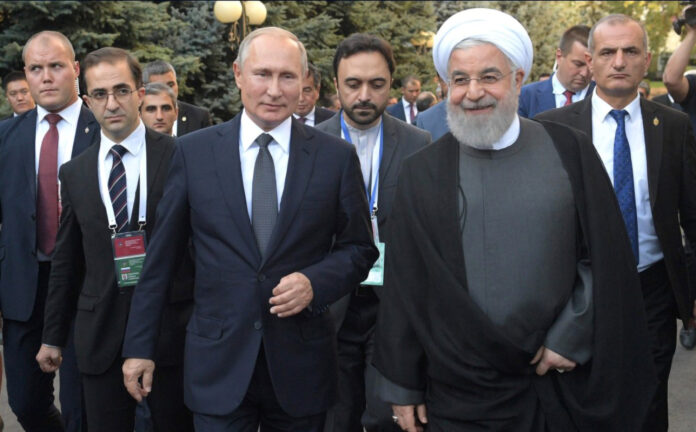In September 2015, when Russia intervened militarily in Syria in order to save the regime of Bashar Al-Assad, guarantor of its strategic “assets” in situ (bases and radars), the maneuver generated a shameful relief among some Westerners. Vladimir Putin was going to fight jihadism and, at the same time, would rid us of the Syrian raïs. Moreover, this projection of forces and power would block Iran’s route to the Mediterranean. In truth, this was wishful thinking.
Understood over the long term, relations between Russia and Iran are ambivalent. We remember that Persia was one of the theaters of the “Great Game” which, from the Middle East to Upper Asia (Central Asia, Afghanistan, Tibet), opposed London to Saint Petersburg. At the time of the Triple Entente (1907), the two capitals agreed on a dividing line between their zones of influence. Later, after Hitler broke the German-Soviet pact, the British and Soviets agreed to occupy Persia, now called “Iran”. In fact, Iranian territory and the Caspian Sea were the main access route for American military equipment destined for the Soviet army. After World War II, Soviet troops eventually withdrew, but this was under Anglo-American pressure.
Although Moscow had apparently given in, it had not abandoned its policy of destabilizing the imperial regime, as the Iran of the Pahlevis was a powerful ally of the West in the Persian Gulf. Things changed in 1979, when an Islamic Republic succeeded the monarchy, with Iman Khomeini as its Supreme Leader. At the beginning of this revolution (a compound of Islamism and Third Worldism), the USSR supported a pro-Soviet tendency in its midst, led by the son of Iman Khomeini (the future “reformist” president Mohammed Khatami would have been part of it). Without much success. When the war between Iran and Iraq broke out (1980-1988), Moscow kept the balance between the belligerents. Subsequently, Yuri Andropov favoured Saddam Hussein and Bassist Iraq (1982). In the eyes of the Iranian-Shiite regime, Moscow became the “little Satan”.
It was thus at the beginning of post-Soviet Russia that a true Russian-Iranian geopolitical partnership was initiated. It was part of the “Primakov doctrine”, the foreign minister of Boris Yeltsin who was building “anti-hegemonic coalitions” with China, India and Iran, to counterbalance the United States. Russia then sold large volumes of arms to Iran and transferred civilian nuclear technology to it (see in particular the story of the Bouchehr power plant). This was only the beginning.
On March 16, 2001, Putin and Khatami signed a pact of civil and military cooperation. Subsequently, Moscow tried to limit the scope of UN resolutions condemning the nuclear enrichment program. Iran was also invited by Russia and China to meetings of the Shanghai Cooperation Organization (SCO). Since then, it has obtained observer status in this forum, whose ultimate goal is to push the West away from Upper Asia (a prospect that is becoming clearer with the withdrawal from Afghanistan).
At that time, vast projects aimed to transform the Russian-Iranian partnership into a great alliance. These two major gas producers (40% of the world’s reserves) were talking about founding a “gas OPEC”. To compete with the Suez route, the opening of a multimodal corridor between Russia and Iran – from the Caspian Sea to the Arabian Gulf – was at one time mentioned (Moscow now favours the Arctic and the Northern Sea Route).
Of course, diplomatic maneuvers and major projects should not hide opposition. The vote of “UN” resolutions condemning Iran, even if watered down by Russian diplomats, and the suspension of a contract for the delivery of S-300 (anti-aircraft systems) damaged the Moscow-Tehran relationship. Above all, Iranian gas, if it crossed Armenia to flow into Europe’s “southern corridor” (the defunct “Nabucco” gas pipeline project), would have competed with Gazprom. The international embargo on Iranian hydrocarbons thus assured Moscow an economic rent.
However, Moscow endorsed the Iranian nuclear agreement signed on 14 July 2015 (the JCPOA). The will to succeed of the People’s Republic of China, whose alliance is essential for Russia, and the need to rely on Iran in order to establish itself in the Middle East, outweighed any prejudices. Finally, the Kremlin wanted (and still wants) to integrate Iran into its geopolitical program, including on a global scale, with the promotion of the BRICS. In Putin’s mind, Iran was to be the new “I” in this emerging world (a configuration that has been devalued to some extent).
On the Syrian front, Russia and Iran operate as true allies, with the combined intervention saving the regime of Bashar Al-Assad. During this war, the Revolutionary Guards, the backbone of the Iranian-Shiite regime, made bases available to the Russian air force, thus belying the thesis of a fierce Persian nationalism hostile to any foreign military presence (when will Russian or Chinese naval facilities be available on the Iranian coast?). It is by means of this alliance that Russia was able to pose as a Middle Eastern power, while admittedly striving to conduct a multi-faceted diplomacy, towards Israel and the Sunni monarchies of the region (see the trip to Moscow of the King of Saudi Arabia, 4-5 October 2017).
Moscow’s and Tehran’s animosity towards the West, and their desire to outdo the United States from the eastern Mediterranean to the Arabian Gulf, are thus the solid cement of an alliance that has changed the balance of power in the northern part of the Middle East. The exit of the United States from the Iranian nuclear agreement (May 2018) and the worsening of the Cold War climate then led to Russian-Iranian strengthened ties. Moscow is supporting Tehran in its showdown with the United States, particularly in the Strait of Hormuz. Signs of the times: the two capitals have signed a pact on intelligence and counter-espionage (January 2021).
In short, if it is possible to speculate on Moscow’s attitude in the event of an Israeli-Iranian war, the observation of facts leads to the thesis of a true Russian-Iranian alliance: the Russian commitment in Syria has not led to the roll-back of the Revolutionary Guards and the Pan-Shiite militias, and the latter have been able to build a “land bridge” from the Arabian Gulf to the Eastern Mediterranean. Possibly reinforced by China, the Russians and Iranians are acting in concert, their objective being to oust the West from the area.
The “sharing of spoils” and its promises allow to overcome the inevitable tensions and friction between the two countries. Reducing this alliance to mere tactical games would be to overlook the strength of sad passions (resentment and revanchism) and the conviction of Russian and Iranian rulers that the time of the West is over. In the end, the Moscow-Tehran alliance is an essential part of the revisionist power bloc that is taking shape with China as its “sponsor”.
Associate professor of history and geography and researcher at the French Institute of Geopolitics (University of Paris VIII). Author of several books, he works within the Thomas More Institute on geopolitical and defense issues in Europe. His research areas cover the Baltic-Black Sea region, post-Soviet Eurasia, and the Mediterranean.




